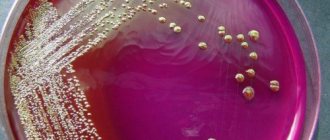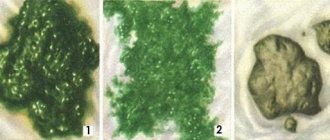Citrobacter (in laboratory stool test results forms designated as C. amalonaticus, C. freundii, C. koseri) belongs to a group of opportunistic bacteria that inhabit the human intestines and feces. With adequate functioning of the immune system, it is not dangerous to health and life.
A disease caused by Citrobacter can only be discussed in a situation where immunity is reduced and the number of normal representatives of the intestinal microflora is significantly lower than normal.
What to do in such a situation? To get started, we recommend reading this article. This article describes in detail methods of controlling parasites. We also recommend that you consult a specialist. Read the article >>>
Citrobacter freundii is a type of microorganism.
What is Citrobacter freundii?
The Citrobacter freundii strain can be found in all parts of the human large intestine. Nevertheless, it is able to leave its limits when an imbalance of microflora occurs, as a result of which various pathologies begin to develop, affecting the genitourinary system, gastrointestinal tract, gall bladder, and so on.
Cytobacteria in the intestines begin their activity most actively when they enter the baby’s body. They can be found in babies under 1 year of age. In these cases, its manifestations can be detected within 2 hours after entering the body. If the child is over a year old, the development process will take several hours.
You can suspect that a child has been affected by these bacteria based on the following symptoms: rapidly growing malaise, migraine-like pain, a sharp rise in temperature, vomiting and increased frequency of bowel movements on average up to 1 time per hour.
General characteristics of the microbe
Citrobacter spp is a rod-shaped, motile small bacterium that stains red on Gram and is located singly or in pairs on a smear.
This group of microorganisms lacks the ability to form spores and capsules. Citrobacter is a facultative anaerobe whose energy and reproductive cycles can occur both in the presence of oxygen and without it. Bacteria have O-, H- and K-antigen. Their antigenic structure is largely similar to other enterobacteria. The pathogenicity and virulence of Citrobacter is due to the presence of pili, microvilli, adhesin protein, endotoxin, colicin, and enterotoxin. When bacteria enter in large numbers into an uncharacteristic biotope, they cause the development of diseases, especially in people with reduced immunity. Citrobacter is resistant to most antibiotics and disinfectants.
Citrobacter grows on the usual universal nutrient media Endo, Ploskireva, bismuth-sulfite agar at a temperature of 35-36 degrees with the formation on their surface of large, medium-sized colonies of the same type, smooth, convex, shiny. When grown in Hottinger broth, the bacterium causes uniform turbidity with precipitation. The growth of Citrobacter colonies on nutrient media is accompanied by the appearance of an unpleasant odor. Citrobacter ferments glucose to acid and gas, reduces nitrates to nitrites, and has catalase activity.
How can you get infected?
Citrobacter freundii (this is the trivial name for bacteria) is present in soil, water and feces of humans and animals, so the infection is usually transmitted through the fecal-oral route.
Human infection can occur as a result of eating insufficiently pasteurized milk, dairy products and butter produced by unverified manufacturers, as well as as a result of poorly cooked poultry and animal meat.
Bacteria live in entire colonies, their numbers number in the thousands.
Children, especially those with weakened immune systems, can become infected through dirty hands, toys, contact with adults who are carriers of these bacteria, and other household contact methods.
Root causes of infection
The main carriers of infection are animals and people. The Citrobacter present in stool analysis subsequently enters the soil or water along with feces. Feces exposed to environmental conditions become a source of infection. Infection of other people or animals occurs.
The main route of infection is fecal-oralMost often, microorganisms enter the body with:
- milk and dairy products;
- confectionery products;
- chicken meat;
- beef, pork and other types of meat.
Citrobacter freundii can appear in the feces of infants or older children through interaction with care items and toys. Infection occurs when the immune system is significantly weakened.
The route of transmission of the disease is fecal-oral. Citrobacter in infants occurs due to the fault of parents who do not take care of the baby’s personal hygiene and do not properly treat toys and other household items. Microorganisms pose a huge danger to newborns.
Pathology can also be a consequence of contact with contaminated soil. The body is likely to become infected if there is insufficient hand hygiene. In addition, doctors do not recommend eating dirty vegetables and fruits.
Infection can occur as a result of eating under-processed animal products.
Citrobacter freundi in infants
Citrobacteriosis is a very dangerous disease and many parents would do well to become familiar with its causes and symptoms that may occur in a child.
We will consider the general concept of the disease, methods of transmission of infection, sources of the disease and features of the course of citrobacteriosis in infants. Let's also consider the main treatment methods.
Citrobacter are small, mobile rods that are present in the microflora of every person. In turn, citrobacteriosis is a disease caused by Citrobacter bacilli.
Most often, the disease affects the gastrointestinal tract and can involve the biliary and urinary tracts, as well as in some cases the central nervous system, in the inflammatory process.
Causes
Parents have repeatedly heard about poisoning of children in preschool and school institutions, and sometimes of adults. Citrobacter freundi often occurs in infants, especially during the introduction of complementary foods when purchasing low-quality products.
The infection is very active and is easily transmitted orally.
Citrobacter can occur in infants if basic hygiene rules are not followed. We are talking about toys and other contact objects. Infants with weakened immune systems are most susceptible to the disease.
Sometimes the disease has a pronounced poisoning character, but the symptoms are similar to gastritis. In older children, the disease manifests itself after a few hours; in infants, Citrobacter can manifest itself after one and a half to two hours.
Symptoms
The child's body temperature rises sharply to 38.5 degrees. Vomiting and diarrhea are periodically observed, which may intensify and subside.
Adult children report pain in the epigastric region.
If these symptoms appear, you should immediately consult a doctor. The diagnosis of Citrobacter in an infant can only be confirmed after appropriate laboratory tests.
Despite the acute onset of the disease, it is worth reassuring parents, since medicine, with timely intervention, provides a favorable prognosis. The course of the disease lasts an average of 5 days and after surgical treatment, the little patient feels better on the second day.
The disease in children in the first months of life is characterized by an acute onset and resembles enterocolitis and enteritis. The first stool after infection is frequent and liquid, later it becomes abundant with mucus. Sometimes green.
Signs of the baby's anxiety are short-lived and can recur even on the third and fourth day. If your health is important to you, then treatment of Citrobacter in infants should be carried out under the mandatory supervision of a specialist.
Treatment
The analysis performed by laboratory specialists allows us to determine the number of cyrobacteria in the intestinal microflora. But along with establishing the number of these bacteria, a comprehensive analysis is always performed to determine the composition of other pathogenic microorganisms, staphylococci, hemolytic deposits, lactonegative bacteria and others.
Therefore, such an indicator of Citrobacter 10 to 7 degrees in an infant can be detected completely by accident and the child can feel quite well. This suggests that there is no need to rush to the pharmacy for lacto and bifidum drugs. They can only be prescribed by a specialist after a comprehensive laboratory study.
Monobactams - aztreonam or carboxypenicillins - ticarcillin can be used. For the Freundi strain in infants, levofloxacin is used. Severe forms of the disease require the use of strong drugs: carbapenems and fluoroquinolones.
Conclusion
Any diseases in infants that are associated with the digestive tract must be treated in specialized institutions. Self-medication of Citrobacter in infants is not allowed, even with the use of expensive and advertised drugs.
What bacteria are opportunistic?
The most famous and numerous pathogenic microbes of the intestinal family are Enterobacteriaceae. These include the following varieties:
- proteas;
- enterobacters (aerogenes and cloacea);
- Citrobacter freundi;
- Klebsiella pneumonia.
Also, non-hemolytic forms of staphylococcus are constantly present in the intestines. Conditionally pathogenic flora cannot include hemolytic species (dissolving red blood cells); their presence in tests indicates infection. In addition, microbes that take an active part in fat metabolism can be observed. They usually live in the large intestine.
Escherichia coli plays a special role in the normal intestinal flora
Pathogenic microorganisms such as streptococci may be present in small quantities in the gastrointestinal tract. They not only act as causative agents of intestinal infections, but also increase the production of immunoglobulins. In addition, with their help, the body successfully removes some pathogenic bacteria, for example, salmonella and shigella.
It is also worth considering pathogenic bacteria that live in the oral cavity. These are fusobacteria and veillonella, the pathogenicity of which is quite rare. However, if they enter the intestinal microflora, they can cause various quite strong inflammatory processes.
Helicobacter pylori bacterium under a microscope
The bacteria Helicobacter pylori are one of the most studied microorganisms that are part of the opportunistic microflora of the gastrointestinal tract. This species has chosen the stomach as its habitat, and when it actively reproduces, gastritis and bacterial peptic ulcers occur. These bacteria are immune to antimicrobial drugs, and for this reason, the diseases they cause are very difficult to cure.
What is the danger of infection with Citrobacter?
Citrobacter most often affects the urinary and biliary tract, as well as the respiratory tract. There are also frequent cases of nosocomial antigen infections. Overgrown colonies of these bacteria are extremely dangerous to human health, as they can cause the development of diseases such as:
- gastroenteritis;
- meningitis;
- toxic infection;
- brain abscess;
- urological diseases;
- purulent infections;
- sepsis.
Important: in recent years, there have been frequent cases of mass poisoning in preschool institutions and schools. Their cause is a deviation from established standards and cooking technologies. Well, the immediate culprit is Citrobacter freundi, treatment of which should begin immediately.
Prevention measures
To prevent infection, the following recommendations should be followed:
- maintaining hand and perianal hygiene after defecation;
- control of the quality of water, food, adequate introduction of complementary foods to infants;
- antiseptic treatment of toys, devices for expressing milk and feeding;
- compliance with the rules of asepsis and antiseptics of premises in hospitals (reduces the risk of nosocomial infection);
- maintaining cleanliness in the living area.
It is important to maintain a healthy psycho-emotional background, avoid stress, carry out adequate therapy for infectious and inflammatory diseases of a different nature, take multivitamins, observe a protective regime, and avoid bad habits. https://www.youtube.com/embed/nTBBWbRAxvg
Citrobacter infection is a serious disease and often becomes a finding during a comprehensive diagnosis of a patient. Citrobacter rarely poses a real threat to the health and life of the patient, but complications and dangers cannot be underestimated.
Cytobacteriosis: how it occurs and what needs to be done
Cytobacteriosis can occur like any disease of the gastrointestinal tract. This could be enteritis, gastritis, gastroenteritis or severe food poisoning. The incubation period of these bacteria is very short - it is only 2-5 hours.
The disease begins to develop with pain in the epigastric region. Along with this, nausea and vomiting occur, the frequency of which gradually increases. Body temperature rises significantly and can reach 38.5 degrees. The acute phase can last 1-2 days. All other symptoms of cytobacteriosis are quite vague and may well qualify as signs of another disease.
The very first signs of the disease are:
- loose stools and frequent urge to do so;
- frequent vomiting (reflex contractions occur even when there is no food in the stomach, as a result of this
- hydrochloric acid begins to come out).
- Along with these symptoms, pain begins to appear. It gradually becomes more pronounced
- character and affects the entire abdominal cavity. On palpation it intensifies and radiates into the small intestine.
Important: only a specialist can distinguish citrobacteriosis from any other disease after conducting all the necessary examinations and tests, as well as prescribing appropriate treatment.
Citrobacter in infants is different in that the order and intensity of manifestations varies, and they may have certain characteristics:
- At the very first time, citrobacteriosis almost immediately acquires a severe form. At the same time, the body temperature rises sharply (up to 40 degrees), severe vomiting begins, and the child becomes lethargic and inactive. He reacts weakly or not at all to various external stimuli. In this case, emergency hospitalization is indicated;
- the feces become thin and scanty, and green mucus can be found in its composition. As the disease progresses, it becomes more watery and profuse. At this stage, an admixture of blood is possible - this will be a consequence of the development of hemocolitis.
Along with the above symptoms, irritation of the skin and mucous membranes will begin, an allergic syndrome will appear, accompanied by profuse rashes over the entire surface of the body.
Citrobacteriosis in a child is a serious disease
Important: if these signs appear, you need to see a specialist as soon as possible.
Symptoms of the disorder
Citrobacter is rarely present in a stool test in an infant or an adult without symptoms. The clinical picture depends on the harm caused by microorganisms to the microflora and overall health. Common manifestations include:
- decreased appetite;
- prostration;
- rapid loss of body weight;
- signs of vitamin deficiency;
- anemia;
- upset stool with foreign impurities;
- bloating;
- increased gas formation;
- increase in body temperature up to 39 degrees;
- pain syndrome in the stomach.
The patient may have one symptom or all at once. The pronounced intensity of symptoms is present for no more than 6 hours. Then the condition improves slightly.
Lack of appetite is one of the signs of Citrobacter infection
Symptoms in children differ from the manifestations of pathology in adults. The child has:
- temperature increase to 40 degrees;
- strong urge to vomit;
- irritability;
- apathy;
- lethargy;
- loss of interest in surrounding factors;
- loose stool streaked with blood;
- skin rashes accompanied by an itchy sensation.
The disease is most severe in children under one year of age. If symptoms occur, the baby needs urgent hospitalization. Ignoring present signs is dangerous, as the condition can be fatal.
At older ages, the pathology is less intense. However, the child also needs the help of medical professionals. If Citrobacter is present, children become lethargic and refuse to play or eat.
The child constantly has nausea. The baby's weight is rapidly decreasing due to refusal to eat. He begins to lag behind his peers in physical development and feels a chronic loss of strength.
Stool analysis is one of the methods for diagnosing pathology
Citrobacter: how to detect it
Detecting the bacterium Citrobacter in a stool test is quite simple; you just need to properly examine the samples taken.
The presence of a large number of these microorganisms can be considered the main laboratory indicator of why the patient’s intestinal microflora is disturbed (except in cases where there are malignant neoplasms or weakened immunity).
Every person has a citrobacter in their body; its norm does not exceed 10,000 colonies per 1 gram of feces. If this indicator is exceeded, the doctor will immediately diagnose citrobacteriosis.
In the case of young children, stool samples are taken several times and the number of colonies is compared. If it is growing steadily, then action should be taken as quickly as possible.
Citrobacteriosis cannot be diagnosed based on a stool test alone. The specialist will need to conduct a set of studies that will help:
- identify the presence of pathogenic microorganisms that aggravate the course of the disease;
- identify the citrobacter strain in the stool (freundii or diversus) to prevent possible negative consequences and prescribe appropriate treatment.
Recommendations
- "Citrobacter". LPSN
. Retrieved March 1, 2022. - Ong SL, Beatson SA, Totsika M, Forestier S, McEwan AG, Schembri MA. (2010). "Molecular analysis of type 3 fimbrial genes from Escherichia coli, Klebsiella and Citrobacter species". BMC Microbiol
.
10
: 183. doi:10.1186/1471-2180-10-183. PMC 2900259. PMID 20576143. - Greenwood, David; Slack, Richard S. B.; Peutherer, John F.; Barer, Michael R. (2007). Medical Microbiology: A Guide to Microbial Infections: Pathogenesis, Immunity, Laboratory Diagnosis and Control
(17th ed.). Elsevier. pp. 1264–6. ISBN 978-0-7020-4009-2. - ^ a b c d f g gram h i j k l
Babin, Paul S. (2011).
"Section I: Neuroradiology: Case 3". Educational Atlas of Pediatric Imaging
. Time. pp. 44–7. ISBN 978-1-60406-494-0. - ^ a b c
Doran T.I.
(1999). "The role of Citrobacter in clinical illness in children: a review". Clin.
Infect. Dis .
28
(2): 384–94. Doi:10.1086/515106. PMID 10064257. - ^ a b
Feferbaum R., Diniz E.M., Valente M., Jolo S.R., Vieira R.A., Galvani A.L., Zeccon M.E., Araujo M.S., Krebs V. L., Vaz F.A.
(2000). Citrobacter diversus
brain abscess in infancy: a case report."
Arq Neuropsiquiatr
.
58
(3A): 736–40. doi:10.1590/s0004-282×2000000400023. PMID 10973119. - McPherson, S., Gal, P., Ransom, J. L. (2008). "Treatment of Citrobacter koseri
infection of a premature infant with ciprofloxacin and cefotaxime."
Anne Pharmacoter
.
42
(7):1134–8. Doi:10.1345/af.1L008. PMID 18577764.
How to treat
Getting rid of bacteria will not pose any particular problems if the diagnosis was made in a timely manner. When treating, it is extremely important not only to cure the patient, but also to ensure that citrobacteriosis does not develop in the future.
A diet is prescribed in which you should completely exclude fried, peppered, fatty foods, foods that increase putrefactive fermentation and the formation of gases in the intestines. You need to add fermented milk products, fresh vegetables and fruits to your diet.
Drug therapy consists of taking drugs - these are Nifuroxazide and Ciprofloxacin. If the child has Citrobacter, Levofloxacin is optimal. If necessary, Aztreonam can be prescribed.
To exclude the development of the disease, probiotics are again prescribed - Lactobacterin, Bifikol, Bifidumbacterin. In order to facilitate the functioning of the digestive system, Pancreatin, Abomin, Festal are prescribed.
It is important to know that it is prohibited to independently diagnose and prescribe treatment for Citrobacter - this is the prerogative of a specialist. The information in this article is provided for informational purposes only.
Treatment
After conducting a thorough diagnosis and making a final diagnosis, they move on to treating the infection. Therapeutic measures include strict adherence to the diet, etiotropic antimicrobial therapy, as well as measures that eliminate the main symptoms of the disease and improve the general well-being of patients. After eliminating the acute symptoms of the disease, it is necessary to normalize the microflora of the gastrointestinal tract.
Diet therapy consists of excluding from the diet alcohol, fatty, fried, hot, salty, spicy foods, confectionery, bakery products, vegetables and fruits, which contain a lot of fiber and enhance the processes of gas formation in the intestines. Fermented milk products, easily digestible dishes and pureed purees that do not irritate the gastrointestinal mucosa are recommended. It should be steamed. Patients are prescribed fractional meals in small portions every 2-3 hours. A strict diet is a necessary condition during the period of treatment and recovery. Compliance with the principles of proper therapeutic nutrition will allow the body to rehabilitate after illness in 2-3 days.
Vomiting and diarrhea cause the body to lose fluid and minerals. To quickly get rid of toxins, patients need to ensure proper drinking regimen. At the same time, it is advisable to drink not just water, but solutions that restore mineral balance.
Drug treatment of citrobacteriosis:
- Antibiotics - Cefazolin, Ceftriaxone, Ceftazidime and other drugs from the group of cephalosporins, to which the isolated microbe is sensitive, as well as Ciprofloxacin, Levofloxacin, Nifuroxazide, Amikacin, Gentamicin;
- Pre- and probiotics – “Bifiform”, “Acipol”, “Hilak forte”;
- Enterosorbents – “Activated carbon”, “Polysorb”;
- Oral rehydration - “Regidron”, “Gidrovit”, “Normohydron”;
- Enzymatic preparations - “Creon-D”, “Mezim”, “Panzinorm”;
- Antispasmodics – “No-shpa”, “Duspatalin”;
- Remedies for nausea and vomiting – “Motilium”, “Cerucal”;
- Medicines for bloating - “Espumizan”, “Redugaz”;
- Vitamin complexes;
- Immunomodulators.
In severe cases, patients are hospitalized in the infectious diseases department of the hospital, where infusion detoxification therapy is carried out. Patients are given intravenous glucose-saline solutions - Hemodez, Reogluman, Ringer's solution. Some patients require the introduction of blood substitutes and the use of extracorporeal methods of blood purification - plasmapheresis, hemosorption, hemodialysis, ultraviolet and laser irradiation.
Timely and adequate treatment makes the prognosis of the disease favorable. Problems with bowel movements and general well-being can persist for a long time in older people, young children and people with weakened immune systems.
It is possible to defeat parasites!
Antiparasitic Complex® - Reliable and safe removal of parasites in 21 days!
- The composition includes only natural ingredients;
- Does not cause side effects;
- Absolutely safe;
- Protects the liver, heart, lungs, stomach, skin from parasites;
- Removes waste products of parasites from the body.
- Effectively destroys most types of helminths in 21 days.
There is now a preferential program for free packaging. Read expert opinion.
Read further:
Citrobacter Freundi in feces and urine in children and adults, normal, symptoms
Roundworms in the intestines: signs and symptoms of infection, methods of treatment and removal
Conditionally pathogenic microorganisms in men and women: names and photos
Human pathogenic microorganisms in the environment: destruction factors
Coliform bacteria in food: what they are and the reasons for their appearance
Bacteria in the stool of a child, an adult, an infant (iodophilic, lactic acid, opportunistic)
Diagnostics
Diagnosis of citrobacteriosis includes:
- Collecting an epidemiological history and listening to the patient’s complaints.
- Study of the main clinical symptoms - acute onset, diarrhea, intoxication, mucus in the stool.
- Microscopic examination - Gram staining of a smear and identifying small straight red rods in it, located singly or in pairs.
- In a bacteriological laboratory, a microbiological examination of stool or rectal smear is carried out for the presence of Citrobacter and the degree of damage is determined. Normally, there are 10,000 colony-forming units of this type of bacteria per 1 gram of feces. Exceeding this indicator is a sign of pathology. Biomaterial from the patient is inoculated on simple plate media - Endo, Ploskireva, Levin. Cups with crops are placed in a thermostat for a day. On the second day, bacterial growth is studied. Suspicious colonies are subcultured on an accumulation medium - Olkenitsky's three-sugar agar. Identification of an isolated culture includes the study of its biochemical properties. Citrobacter grows well on Simmons medium. Colonies of each species are removed with a needle onto Olkenitsky's medium and complete identification is carried out. Simmons' plate medium allows the isolation of the most common opportunistic enterobacteriaceae. Citrobacter utilizes sodium citrate and changes the color of the medium to blue.
- Serological identification is a more accurate diagnostic method. In the laboratory, an agglutination reaction is performed with polyvalent O-antiserum - CiOA, CiOD and CiOF. If the result is positive, an agglutination reaction is performed with sera to O-antigens, which were part of the polyvalent antiserum.
- Bacterial culture of the average portion of morning urine in a quantitative way allows us to determine the etiological role of Citrobacter in the development of diseases of the urinary system.
- The pathogenic properties of Citrobacter are determined in a bioassay on white mice. They are injected intraperitoneally with a suspension of microbial cells obtained from a bacterial culture, which was isolated from the feces of animals that died from this infection. The death of infected mice within 2-3 days after the experiment is a sign of the pathogenicity of the culture.
- A method for rapid identification of microorganisms is phage typing.
- General clinical blood test.
- Ultrasound of the gallbladder, pancreas, kidneys.
- Endoscopic examination of the stomach and intestines.











